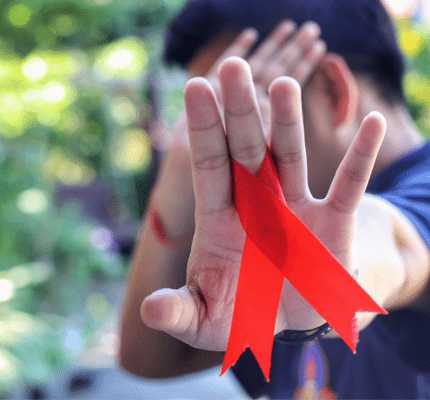
Mixed Messages About HIV May Increase Stigma
Stigma associated with HIV can lead to negative health consequences, such as delayed diagnosis and the unintentional spread of the virus. Positive media portrayals may reduce HIV stigma, but in the current media environment, people can be exposed to multiple, competing narratives about the virus. These narratives may emanate from user-generated content or from health campaigns that intentionally or unintentionally offer competing narratives about HIV. In a new article published in NCA’s Journal of Applied Communication Research, Chunbo Ren and Ming Lei examine how positive and negative portrayals of living with HIV, in combination with narratives about how people contract the virus, affect stigma.
HIV Stigma and Media Frames
Stigma and negative stereotypes about HIV have been perpetuated in part by media portrayals. Early media portrayals of people living with HIV often blamed people for having contracted the virus and associated their diagnosis with “deviant” activity. Some positive portrayals of people with HIV have emerged, such as “the survivor frame, in which PLHIV (people living with HIV) are portrayed as healthy, happy, and helping others through a fighting spirit” and the “normal frame, which suggests that PLHIV are free from blame and live their lives in either [a] neutral or positive manner like people not affected by HIV/AIDS.”
People may also see stories in the media about how people contracted HIV. Media frames for these stories may emphasize that people were in control of the behavior that caused them to contract HIV. For example, some narratives emphasize that people contracted HIV through intravenous drug use or sex (high controllability of HIV onset). These narratives may cause media audiences to blame people with HIV for their condition and may serve to increase stigma. In contrast, other media frames may emphasize that people’s behavior was not responsible for their HIV diagnosis, as in the case of stories about blood transfusions or mother-to-child HIV transmission at birth (low controllability of HIV onset). People exposed to these narratives may be less likely to blame people with HIV for their condition and more likely to view them as “victims.”
The Study
The researchers recruited 443 undergraduate students from a U.S. university for the study. The students filled out a survey prior to and following exposure to one of four conditions where they received a message with a positive or negative living-with-HIV portrayal paired with high or low controllability of HIV onset. Stigma was measured through questions that assessed “stigmatizing attitudes,” such as whether participants reported blaming or shaming individuals for their HIV diagnosis. The researchers also analyzed how the message combinations influenced whether participants were comfortable interacting with people with HIV and their support for “coercive measures,” such as not allowing HIV-positive and HIV-negative people to share the same hospital room.
The four conditions featured posters depicting three fictional characters, Ben, Jeff, and Greg, in different scenarios. All three characters were featured on all posters. In the positive portrayal with high controllability, the characters had contracted HIV through sex and still lived happy, fulfilling lives. In the positive portrayal with low controllability, they had contracted HIV either through a tattoo parlor, blood transfusion, or a partner who cheated, and still lived happy, fulfilling lives. In the negative portrayal with high controllability, they had contracted HIV through sex, but were shown as experiencing stigma due to the disease. In the negative portrayal with low controllability, the same low controllability scenarios were presented, along with a narrative about the HIV stigma the characters experienced.
Results
Stigmatizing attitudes toward people with HIV increased when participants were exposed to the high controllability onset in both the positive and negative portrayal conditions. However, neither of the low controllability combinations had any effect on stigmatizing attitudes. When participants were exposed to a combination of a positive portrayal and low controllability onset, they were more likely to report that they would interact socially with people with HIV. None of the other combinations had any effect on intentions to interact with people with HIV. The results also showed that participants who were exposed to a negative portrayal combined with a high controllability frame were more likely to support coercive measures against people with HIV. None of the other combinations had any effect on support for coercive measures.
Implications
The results show that positive portrayals of living with HIV, even in combination with low controllability onset, are not effective at reducing stigmatizing attitudes or at reducing support for coercive measures. Thus, Ren and Lei suggest that health communication professionals may want to consider that positive portrayals may be helpful in mitigating only some aspects of stigma related to people living with HIV. In addition, the authors argue that health communication professionals should consider whether their messages contain multiple frames, which may result in negative effects (such as an increase in stigmatizing attitudes) or no effect at all, as in the case of many of the combinations.



